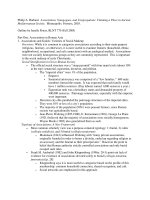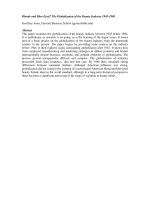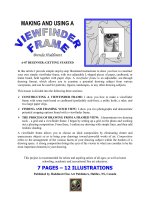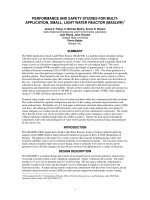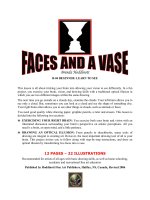Tài liệu Orthodontists and patient´s aesthetic perception to different types of profi les modifi ed by a computer program pdf
Bạn đang xem bản rút gọn của tài liệu. Xem và tải ngay bản đầy đủ của tài liệu tại đây (170.22 KB, 7 trang )
Facultad de Odontología
Vol. 16, No. 3
July-September 2012
pp 164-170
Revista Odontológica Mexicana
ORIGINAL RESEARCH
www.medigraphic.org.mx
Orthodontists and patient´s aesthetic perception
to different types of profi les modifi ed by a
computer program
Percepción estética de cirujanos dentistas, ortodoncistas
y pacientes a diferentes tipos de perfi les modifi cados
por un programa de computadora
María Fernanda Quiroz,* Enrique Grageda
§
* Third year resident, Orthodontics Department, Graduate School,
National School of Dentistry, National University of Mexico.
§
Professor, Orthodontics Department, Graduate School, National
School of Dentistry, National University of Mexico.
This article can be read in its full version in the following page:
/>ABSTRACT
Introduction: The concept of facial beauty and profi le harmony play
a decisive role in social relationships of all people. Therefore, it is
intensely studied in scientifi c
research. Objective: Assess esthetic
perception that dentists, orthodontists and patients discern on com-
puter-modifi ed profi les. Materials: Using two Dolphin Imaging and
Management
®
program modifi ed profi les, assessment made by 30
patients, 30 orthodontists and 30 maxillofacial surgeons attached
to the Graduate School, National School of Dentistry, National Uni-
versity of Mexico. Methods: Photographs and cephalographs of a
Mexican man and a woman were used. Position of upper and lower
jaws were modifi ed by the Dolphin Imaging and Management
®
pro-
gram, so as to create two sequences. 90 subjects (30 orthodontists,
30 maxillofacial surgeons and 30 patients of the Graduate School)
assessed profi les in the visual, analogical scale. SPSS was used
to process statistical analysis. Scores given by surgeons, ortho-
dontists and patients for each profi le were compared with the help
of Kruskall-Wallis tests. Results: Reliability within evaluators was
deemed as «good». Facial attraction perception of orthodontists and
maxillofacial surgeons was generally in agreement. Patients thought
otherwise. Interactions of anterior-posterior and vertical dimension,
as well as amount of change between each dimension infl uences
perception of facial attraction. Conclusions: Results suggest that
facial attractiveness preferences among orthodontists and maxillo-
facial surgeons were generally in agreement. This information can
help clinicians to plan treatment and suggest recommendations.
RESUMEN
Introducción: Los conceptos de belleza del rostro y armonía
del perfil desempeñan una función decisiva en el terreno de las
relaciones sociales del hombre, por lo cual es tema de intenso
estudio en investigaciones científicas. Objetivo: Evaluar la per-
cepción estética que sobre un perfil modificado por computadora
tienen los cirujanos dentistas, ortodoncistas y pacientes. Mate-
riales: 2 perfiles modificados por el programa Dolphin Imaging
and Management
®
, 30 pacientes, 30 ortodoncistas y 30 cirujanos
maxilofaciales de la DEPeI. Métodos: Se utilizaron fotografías y
cefalografías de un hombre y una mujer mexicana. La posición
de la mandíbula y del maxilar fueron modificados por el programa
Dolphin Imaging and Management
®
creándose dos secuencias,
90 personas (30 ortodoncistas, 30 cirujanos maxilofaciales,
30 pacientes de la DEPeI) evaluaron los perfiles en la escala
analógica visual, todos los análisis estadísticos fueron procesa-
dos usando SPSS. Las puntuaciones dadas por cirujanos, ort-
odoncistas y pacientes para cada perfil fueron comparados con
pruebas Kruskal-Wallis. Resultados: La confiabilidad dentro de
los evaluadores fue buena y se encontró que las percepciones
del atractivo facial entre cirujanos maxilofaciales y ortodoncistas
contra pacientes tuvieron concordancia en general. Las interac-
ciones de la dimensión vertical y anteroposterior, así como la
magnitud de cambio entre cada dimensión influye en la percep-
ción del atractivo facial. Conclusiones: Los resultados sugieren
que las preferencias del atractivo facial por ortodoncistas y ciru-
janos dentistas están generalmente en acuerdo. Esta información
puede ayudar a los clínicos en la planeación del tratamiento y al
hacer recomendaciones.
Key words: Aesthetics, profi le, perception.
Palabras clave: Estética, perfi l, percepción.
www.medigraphic.org.mx
Revista Odontológica Mexicana 2012;16 (3): 164-170
165
www.medigraphic.org.mx
INTRODUCTION
Modern society grants strong emphasis to physical
attractiveness. Facial esthetics is an important facial
attribute upon which many opinions and perceptions
are conceived. Cognitive science researchers pro-
posed the idea that facial attractiveness perception
can be a biological impetus in the selection of partners
for human reproduction. For women, facial symmetry
and average proportions in men have been infl uencing
trait for selection process. For men, secondary sexual
characteristicsis is the fi rst infl uencing trait in selection
of women.
1-3
Results of these studies came to the conclusion that
population rules and sexual dimorphism bear infl uence
on the perception of facial attractiveness. Dental-facial
self-perception is an important factor for seeking orth-
odontic treatment.
4-7
This is the main reason driving
adults to seek treatment.
8,9
The strongest motivation
for adults subjected to orthognathic surgery was the
desire to improve facial esthetics.
10-14
Arpino & al
15
found that orthognathic surgery was the one bearing
less tolerance to attractive profi le preference devia-
tions when compared to clinical surgery. Self percep-
tion of poor esthetics is not always correlated to mor-
phometric measures such as physical characteristics
and cephalometric values.
16-19
A recent study on psycho-social effects of orthogna-
thic surgery concluded that orthognathic patients gen-
erally experiment self-esteem improvement and better
accept facial and bodily image.
20
The fi nal goal of orthodontic treatment is to improve
dental-facial complex harmony achieving proper bal-
ance of bone, dental and soft tissues with respect to
esthetics and function.
21-24
Assessment of soft tissues
is an important aspect of orthodontic diagnosis and
treatment planning; this encompasses profi le analysis.
Soft tissue profi le experiments changes associated to
surgical or non-surgical orthodontic treatments. These
have been previously studied. Orthodontists as well
as surgeons are involved in treatments affecting facial
profi le. Therefore, their perception of facial esthetics
bears infl uence in treatment planning. Nevertheless,
many surgical plans are visualized in the anterior-
posterior plane through either conventional tracings or
computer-assisted tracings to predict soft tissue pro-
fi le. Ackerman and Profi t
25
provided a clinical guide for
esthetic profi le. Clinical evaluations notwithstanding, a
subjective element in personal perception of esthetic
profi le is to be expected. Moreover, surgeons and or-
thodontists ´ perceptions of esthetics can be consid-
ered the «golden rule» which the treatment will try to
attain. Nevertheless, the clinician might not take into
consideration patient´s perceptions. Orthodontists
and clinicians must take into account the subjective
response of the patient to what he considers an es-
thetic profi le. This information can ease information
among clinicians and patients. Previous methods used
to analyze an attractive facial profi le include the follow-
ing: line tracing, silhouettes, facial pictures and slides.
A study conducted by Spiropoulos and Halazonetis
26
concluded that the perception of an attractive profi le
was affected by the soft tissue profi le contour; they ob-
served adequate correlation of general public and or-
thodontists. Nevertheless, orthodontists tend to grant
higher scores that general public.
The purpose of this study was to compare attractive
male and female esthetic profi le perception in a group
composed of dentists, students, and general public.
MATERIAL AND METHODS
The sample was composed of 30 dentists, 30 or-
thodontists and 30 patients attending the Graduate
School of the National School of Dentistry, National
University of Mexico (UNAM). Dolphin Imaging and
Graphics program
®
was used to scan profile pic-
tures of Mexican men and women either with Class
I or normal cephalometric values. Using Dolphin
Imaging and Graphics
®
lateral cephalograms of 2
subjects in natural posture were scanned. Lateral
cephalogram and profile images of each subject
were adjusted using a simulated computer-analysis
used for orthognathic surgery. Original images (M4
in figure 1 and F5 in figure 2) with their respective
lateral cephalometries were used to generate anoth-
er 6 manipulated images. In these created images,
hard tissue normal values were altered in at least
two standard deviations. Facial profile images were
digitally manipulated in the anterior-posterior plane
with little or no changes in the vertical plane. This
was performed so that each generated profile would
have a normal vertical proportion. These seven pro-
files were used for the possible growth of upper and
lower jaw variations, as well as a bi-maxillary protru-
sive profile typical of Mexican subjects, and bi-maxil-
lary retruded profile representing the typical straight
profile in Caucasian subjects. Each image only had
one manipulated dental or skeletal component.
Mexican female and male profiles are as follows: M1
and F3 (bi-maxillary protrusion). These represent
profiles with an advanced degree of upper and lower
alveolar segments with upper and lower increase of
incisor inclination which produces protrusion of up-
per and lower lip without altering the lower jaw ´s
anterior-posterior profusion. M2 and F 4 (lower jaw
Quiroz MF et al. Orthodontists and patient ´s aesthetic perception to different types of profi les modifi ed by a computer program
166
www.medigraphic.org.mx
protrusion) represent profiles having only lower jaw
development. M 3 and F 1 (lower jaw retrusion) rep-
resent profiles with posterior positioning only in the
lower jaw. M4 and F5 (normal profile) represented
Mexican profiles with skeletal Class 1 basal relation
and incisor Class 1 with average of cephalometric
normal values. These were used as templates from
which the other profiles derived. M5 and F2 (upper
jaw retrusion) were digitally-constructed profiles
with only maxillary posterior placement. M6 and F6
were digitally built with only upper jaw anterior de-
velopment. M7 and F7 (bi-maxillary retrusion) were
digitally built to represent flat profiles with straight
upper and lower incisors, and lesser anterior protru-
sion of alveolar segments according to features of
Caucasian profiles.
Participants were asked to evaluate the 7 profi les
given for each gender in a scale of 1 (very attractive)
to 7 (less attractive), with no repetitions when evalu-
ating in one session. All statistical analyses were
processed using SPSS. Scores given by surgeons,
orthodontists and patients for each profi le were com-
pared through Kruskal-Wallis tests. Evaluation aver-
ages for each profi le were also calculated.
RESULTS
The sample included 90 participants; 38.9% male
and 61.1% female. The three evaluating groups con-
curred, within the scope of male profi les, that normal
profi le (M4) and lower jaw protrusion (M2) were as-
sessed as most and less attractive respectively.
There was no significant difference in values for
bimaxillary protrusion (M1), upper jaw retrusion
(M5) and maxillary protrusion (M6). Significant dif-
ferences were found in punctuation when assessing,
Figure 2. Female profi les:
F1, retruded lower jaw, F2,
retruded upper jaw, F3, bi-
maxillary protrusion, F4,
lower jaw protrusion, F5,
normal profile, F6, protru-
sive upper jaw, F7 bimaxil-
lary retrusion.
Figure 1. Male profi les: M1
bimaxillary protrusion, M2,
mandibular protrusion, M3,
retruded lower jaw, M4,
normal profi le, M5 retruded
upper jaw, M6 protrusive
upper jaw, M7, bimaxillary
retrusion.
Revista Odontológica Mexicana 2012;16 (3): 164-170
167
www.medigraphic.org.mx
lower jaw protrusion (M2), lower jaw retrusion (M3),
normal profile (M4) and bi-maxillary retrusion (M7,
P: 001).
Paired comparisons showed that O placed M2 in a
worse position than DDS and P. DDS assessed M3 as
the least attractive when compared with O and P. DDS
and O assessed M4 as slightly more attractive than P.
All three groups considered M4 as the least attractive
of each group. DDS allotted M7 higher scores than O.
When studying female profi les, bimaxillary protru-
sion (F7) was considered most attractive by DDS and
P. O, considered normal profi le (F5) as the most at-
tractive. Lower jaw protrusion (F4) was considered
the least attractive group by all three groups. There
was no signifi cant scoring difference for the following:
lower jaw retrusion (F1), upper jaw retrusion (F2) bi-
maxillary protrusion (F3) and normal profi le (F5).
Signifi cant differences were found in the following
assessments: lower jaw protrusion (F4), upper jaw
protrusion (F6) and bimaxillary retrusion (F7). Paired
comparisons found that DDS and O assessed F4 as
less attractive than P. all three groups considered F4
as the less attractive. evaluated F6 as most attractive,
in disagreement with P. F7 average assessed by DDS
was approximately one rung lower in comparison with
O and P. All three groups determined that F7 was at
the bottom of the table. Table IV shows high and posi-
tive correlations in the assessment of male and female
esthetics. Correlation in evaluation o female esthetics
was important only between groups O and P. Never-
theless, all correlations in evaluation of female esthet-
ics were important.
DISCUSSION
Improvements in research methodology for this
study were conducted, in contrast with Lew & al ´s
previous study. Both studies were conducted, at dif-
ferent times, in the same segment of Asian population.
Our study included male and female profi le analysis.
Moreover, generated profiles included images with
maxillary, mandibular or dental components manipu-
lation, belonging to skeletal Class II and III with iso-
lated mandibular discrepancies. Profiles of patients
where orthodontic-surgical treatments were planned
were excluded, since many orthodontic-surgical treat-
ment plans would normally include correction of verti-
cal skeletal discrepancies independently of patients´s
concerns.
Adults selected from the general public were cho-
sen instead of teenagers, because of recent tendency
of adults to seek orthodontic treatment or orthognathic
surgery. Black and white images were developed to
eliminate any possible infl uence of hair and skin color.
Manipulated profi les were generated without extreme
anterior-posterior changes in hard tissue profile, to
thus provide more clinically realistic soft tissue pro-
fi les. Classifi cation order was different between both
sets of male and female profi les to prevent recognition
patterns during analysis.
Table I. Comparative data on profi le perception in groups of dentists, orthodontists and patients.
D O P
Dentists Orthodontists Patients
Photograph n = 30 n = 30 n = 30 p*
Male
M1 (bimaxillary protrusion) 5.77 (0.80) 4.97 (1.67) 5.24 (1.71) 0.106
M2 (lower jaw protrusion) 6.23 (0.88) 6.75 (0.79) 6.05 (1.58) -0.001
M3 (retruded lower jaw) 5.68 (1.19) 3.68 (1.71) 3.59 (1.78) -0.001
M4 (normal profi le) 1.71 (0.86) 1.99 (1.24) 2.50 (1.32) -0.001
M5 (maxilar retrusivo) 3.26 (1.09) 3.91 (1.46) 3.69 (1.76) 0.096
M6 (upper jaw protrusion) 3.29 (1.19) 2.82 (1.35) 3.13 (1.56) 0.152
M7 (bimaxillary retrusion) 2.13 (1.20) 3.88 (1.50) 3.78 (1.78) -0.001
Female
F1 (retruded lower jaw) 5.81 (0.95) 5.03 (1.59) 4.87 (1.95) 0.080
F2 (retruded upper jaw) 4.80 (1.13) 5.28 (1.03) 5.03 (1.36) 0.182
F3 (bimaxillary protrusion) 4.32 (0.91) 3.75 (1.55) 3.90 (1.61) 0.214
F4 (protrusive lower jaw) 6.61 (0.72) 6.45 (1.13) 5.81 (1.51) -0.001
F5 (normal profi le) 1.93 (0.69) 2.33 (1.24) 2.53 (1.48) 0.272
F6 (protrusive upper jaw) 3.00 (1.03) 2.76 (1.32) 3.45 (1.52) 0.002
F7 (bimaxillary retrusion) 1.45 (0.77) 2.44 (1.43) 2.41 (1.74) 0.002
* Data compared with Kruskal-Wallis test.
Quiroz MF et al. Orthodontists and patient ´s aesthetic perception to different types of profi les modifi ed by a computer program
168
www.medigraphic.org.mx
Este documento es elaborado por Medigraphic
In both genders, flat profile, (normal or with
bimaxillary protrusion) was perceived as the most
attractive, whereas lower-jaw prognathism was
perceived by all three groups as the least attrac-
tive. General public agrees with the research con-
ducted by Mantzikos and Lew & al with respect to
extreme limits of facial attractiveness. In all three
groups, normal profile, or bimaxillary retrusion pro-
file in males (M4, M7) and in females (F5, F7) were
considered to be placed at the end of the attractive-
ness table. This similarity in perception confirms the
usual treatment aim, that is to say, a straight profile,
even in the case of Mexican patients. DDS and O
groups conferred significantly lesser scores to M4
when compared to scores conferred by P. This then
shows the existence in DDS and O of a trend to per-
ceive M4 as more attractive than the P group. Nev-
ertheless, in general terms, all 3 groups assessed
M4 as the most attractive option. In a similar fash-
ion, DDS showed trend to evaluate M7 more attrac-
tive than O and P. This can reflect influence of the
education received by orthodontists and surgeons in
a trend to improve profile to resemble more Cauca-
sian features than Mexican parameters.
Similar evaluation patterns were also observed for
female profi le with bimaxillary protrusion (F7) which
DDS group assesses as more attractive than groups O
or P. This suggests that DDS group considers bimax-
illary retrusion as an attractive, post-treatment profi le
for Chinese patients, while P group might consider
this profi le as barely acceptable. Could this point out
to the idea that Mexican dentists experience a trend
of overcorrecting, regardless of gender? Could it be
construed that exposition to mass media for Latin spe-
cialists training might infl uence their perceptions? Is
culture shock affecting perception of profi le attractive-
ness as has been shown by other studies? It would be
interesting to conduct a separate study to assess how
Caucasian and Mexican DDS and P groups perceive
what can be considered as an attractive profi le.
In instances of lower jaw protrusion in males,
(4), group O granted higher scores than DDS and P
groups. This can mean that groups DDS and P are
more tolerant to mandibular protrusion than O group.
For the equivalent in female profile (F4), group P
granted lower scores than DDS and O groups. This
might suggest that group P can be more tolerant to
mandibular protrusion than groups DDS and O. Never-
theless, the difference average margin was narrower
and closer, and with lesser clinical importance for both
genders, since all 3 groups determined that profi les
with mandibular protrusion were the least attractive of
all 7 profi les.
The fact of limiting evaluation to one lower jaw
per image could allow identification, meanwhile
lower or upper jaw problem was critically more in-
fluencing in the perception of facial esthetics. This
concept is supported in the present paper where
profiles with lower jaw protrusion or retrusion were
perceived as less attractive than profiles with upper
jaw protrusion or retrusion. This suggests that the
position of the lower jaw is more critical than the
position of the upper jaw in the process of evalu-
ating patients, either with or without dental knowl-
edge. Even though one single lower jaw discrep-
ancy cannot be commonly taken into account in
clinical situations, many skeletal malocclusions in-
volve upper and lower jaws. This suggests that per-
ception of surgical success at the end of treatment
can depend more on the proper anterior-posterior
position of the lower jaw to a greater extent than
the position of the upper jaw in cases of upper and
lower jaw surgery. Another obvious fact was that
male profile with bimaxillary protrusion was not well
accepted by either of the three groups. This differs
with findings reported by Manganzini et al, where
male profile with skeletal bimaxillary protrusion
was deemed as attractive aswhen they showed bi-
maxillary retrusion. Female profile with bimaxillary
protrusion was perceived as slightly more attractive
than its male counterpart, based on the lower eval-
uation average granted by all three groups. This
discovery suggests that bimaxillary protrusion is
more acceptable in Mexican females than in males
within the scope of the Latin community.
An interesting fi nding was the fact thatgroups O and
P assessed male profi le with lower jaw protrusion as
more attractive than group DDS. This discovery tends
to contradict psychoanalysts conclusions who state
that a well developed mandible, with a strong chin is
a secondary desirable sexual characteristic associ-
ated to a good facial attractiveness and preferred in
women selection. Do these results indicate a change
in trends in the perception of male profi le in the Latin
community? Does this mean that Latin male profi le-
with female profi le elements is more desirable from the
public´s point of view? PENTO-Voak et al found that
female preferences for facial characteristic changed
during menstrual cycle: during phases when concep-
tion was less probable, lesser masculine features
were preferred. Could the high number of women par-
ticipating the group P have contributed to low evalu-
ation scores? Could these preferences hypothesis
alter feminine perception of masculine attractiveness,
and could it be applied to profi le preferences? Future
research in this fi eld could prove to be interesting. A
Revista Odontológica Mexicana 2012;16 (3): 164-170
169
www.medigraphic.org.mx
study conducted by Cochrane et al found that Class
II profi le was perceived as less attractive by group O
and general public in Caucasian population This was
not the case with Latin groups O and P in this study.
This contrast could be a result of ethnic and cultural
factors infl uencing perception. Future research could
confi rm this observation and could infl uence in future
treatment considerations, especially in patients com-
ing from inter-racial communities.
Perceptual trend in female profi le of all three groups
was highly correlated. This could mean that DDS, O
and P groups are more in agreement when it comes
to assess female esthetic profi le. A possible contribu-
tion to this discovery is social exposure to mass media
which sometimes highlight physical shape and face.
Correlations between DDS and O groups, and DDS
and P groups were not statistically signifi cant. Nev-
ertheless, DDS and P groups correlation coeffi cient
suggests that perception of O group could have been
infl uenced by dental education. Lack of important cor-
relation in male esthetic perception among DDS and
other samples suggests a difference in perception of
male profile. This can embody clinical implications
where DDS group could have different esthetic criteria
than other groups.
CONCLUSIONS
Normal profi le, and bi-retruded bimaxillary profi le
were perceived as the most attractive by Mexican
DDS, Orthodontists and Patients. Mandibular protru-
sion profi le, in males and females, was perceived by
the three groups as the least attractive. Orthodontists
and Patients were more tolerant tomale mandibular re-
trusive profi le than Dentists. Female bi-protrusive pro-
fi lewas better accepted than male bi-protrusive profi le.
Dentists, Orthodontists and Patients showed similar
perception for different male and female profi les. All
three groups showed high correlation when scoring fe-
male profi les. In the case of male profi les, perception
of Orthodontists and Patients was not signifi cantly cor-
related with Dentists.
REFERENCES
1. Langlois JH, Roggman LA. Attractive faces are only average.
Psychol Sci 1990; 1: 115-21.
2. Grammer K, Thornhill R. Human (Homo sapiens) facial attrac-
tiveness and sexual selection: the role of symmetry and aver-
ageness. J Comp Psychol 1994; 108; 233-42.
3. Thornhill R, Gangestad SW. Facial attractiveness. Trends in
Cognitive Sciences 1999; 3: 452-9.
4. Shaw WC. Factors infl uencing the desire for orthodontic treat-
ment. Eur J Orthod 1981; 3: 151-62.
5. Gosney MBE. An investigation into some of the factors infl uenc-
ing the desire for orthodontic treatment. Br J Orthod 1986; 13:
87-94.
6. Birkeland K, Bøe OE, Wisth PJ. Orthodontic concern among
11-year-old children and their parents compared with orthodon-
tic treatment need assessed by index of orthodontic treatment
need. Am J Orthod Dentofacial Orthop 1996; 110: 197-205.
7. Tuominen ML, Tuominen RJ, Nyström M. Subjective orthodontic
treatment need and perceived dental appearance among young
Finnish adults with and without previous orthodontic treatment.
Comm Dent Health 1994; 11: 29-33.
8. Salonen L, Mohlin B, Götzlinger B, Helldén L. Need and demand
for orthodontic treatment in an adult Swedish population. Eur J
Orthod 1992; 14: 359-68.
9. Lew KK. Attitudes and perceptions of adults towards orthodontic
treatment in an Asian community. Comm Dent Oral Epidemiol
1993; 21: 31-5.
10. Kiyak HA, Holh T, Sherrick P, West RA, McNeill RW, Bucher
F. Sex differences in motives for and outcomes of orthognathic
surgery. J Oral Surg 1981; 39: 757-64.
11. Jacobson A. Psychological aspects of dentofacial aesthetics and
orthognathic surgery. Angle Orthod 1984; 54: 18-35.
12. Flanary CM, Barnwell GM, Alexander JM. Patient perceptions of
orthognathic surgery. Am J Orthod 1985; 88: 137-45.
13. McKiernan EXF, McKiernan F, Jones ML. Psychological profi les
and motives of adults seeking orthodontic treatment. Int J Adult
Orthod Orthognath Surg 1992; 7: 187-98.
14. Rivera SM, Hatch JP, Dolce C, Bays RA, Van Sickels JE, Rugh
JD. Patients’ own reasons and patient-perceived recommenda-
tions for orthognathic surgery. Am J Orthod Dentofacial Orthop
2000; 118: 134-40.
15. Arpino VJ, Giddon DB, BeGole EA, Evans CA. Presurgical pro-
fi le preferences of patients and clinicians. Am J Orthod Dentofa-
cial Orthop 1998; 114: 631-7.
16. Bell R, Kiyak HA, Joondeph DR, McNeill RW, Wallen TR. Per-
ceptions of facial profi le and their infl uence on the decision to
undergo orthognathic surgery. Am J Orthod 1985; 88: 323-32.
17. Maxwell R, Kiyak HA. Dentofacial appearance: a comparison of
patient self assessment techniques. Int J Adult Orthod Orthog-
nath Surg 1991; 6: 123-31.
18. Wilmot JJ, Barber HD, Chou DG, Vig KWL. Associations between
severity of dentofacial deformity and motivation for orthodontic-
orthognathic surgery treatment. Angle Orthod 1993; 63: 283-8.
19. Giddon DB. Orthodontic applications of psychological and
perceptual studies of facial esthetics. Semin Orthod 1995; 1:
82-93.
20. Hunt OT, Johnston CD, Hepper PG, Burden DJ. The psychoso-
cial impact of orthognathic surgery: a systematic review. Am J
Orthod Dentofacial Orthop 2001; 120: 490-7.
21.
Ackerman JL, Proffi t WR, Sarver DM. The emerging soft tissue
paradigm in orthodontic diagnosis and treatment planning. Clin
Orthod Res 1999; 2: 49-52.
22. Bergman RT. Cephalometric soft tissue facial analysis. Am J Or-
thod Dentofacial Orthop 1999; 116: 373-89.
23. Arnett GW, Jelic JS, Kim J, Cummings DR, Beress A, Worley
CM, Jr et al. Soft tissue cephalometric analysis: diagnosis and
treatment planning of dentofacial deformity. Am J Orthod Dento-
facial Orthop 1999; 116: 239-53.
24. Arnett GW, Bergman RT. Facial keys to orthodontic diagnosis
and treatment planning: part II. Am J Orthod Dentofacial Orthop
1993; 103: 395-411.
25. Ackerman JL, Proffi t WR. Soft tissue limitations in orthodontics:
treatment planning guidelines. Angle Orthod 1997; 67: 327-36.
26. Spyropoulos MN, Halazonetis DJ. Signifi cance of the soft tissue
profi le on facial esthetics. Am J Orthod Dentofacial Orthop 2001;
119: 464-71.
Quiroz MF et al. Orthodontists and patient ´s aesthetic perception to different types of profi les modifi ed by a computer program
170
www.medigraphic.org.mx
RECOMMENDED LITERATURE
1. Macgregor FC. Social and psychological implications of dentofa-
cial disfi gurement. Angle Orthod 1970; 40: 231-3.
2. Dion KK, Berschield E, Walster E. What is beautiful is good. J
Pers Soc Psychol 1972; 24: 285-90.
3. Clifford MM, Walster E. The effects of physical attractiveness on
teacher expectations. Sociol Edu 1973; 46: 248-58.
4. Shaw WC. The infl uence of children’s dentofacial appearance on
their social attractiveness as judged by peers and lay adults. Am
J Orthod 1981; 79: 399-415.
5. Bull RHC. Society’s reactions to facial disfi gurements. Dent Up-
date 1990; 17: 202-5.
6. Tobiasen JM, Hiebert JM. Clefting and psychosocial adjustment.
Infl uence of facial aesthetics. Clin Plast Surg 1993; 20: 623-31.
Mailing address:
María Fernanda Quiroz
